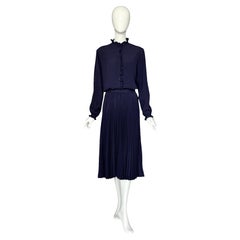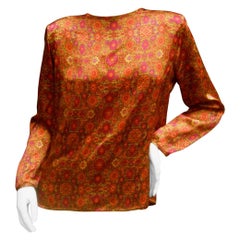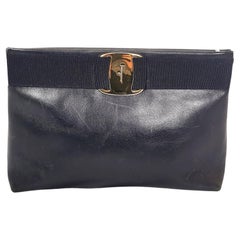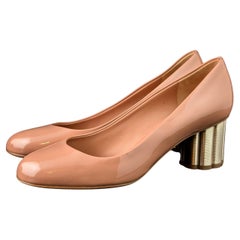Salvatore Ferragamo
A perfectionist who as a child crafted a pair of white shoes for his sister’s first holy communion because his parents couldn’t afford new footwear, Salvatore Ferragamo was ambitious from his earliest days. The young Italian shoemaker established in the years that followed what would one day become a fashion empire — the highly profitable multinational family-owned and -operated luxury brand today counts more than 600 stores in 96 countries around the world, and vintage Salvatore Ferragamo shoes, belts, handbags and other clothing and accessories are objects of desire for fashion lovers everywhere.
Salvatore Ferragamo sought an education in the art of shoemaking when he was eleven — he apprenticed with a local shoemaker and spent a short time in nearby Naples learning what he could at a shoe factory. He opened his first shop with a handful of workers the following year, and in 1914 — when he was still a teenager — Ferragamo emigrated to America, just as his siblings had before him, seeking new opportunities for work and to learn in the footwear trade.
After securing a job at the Plant Shoe Factory in Boston, Massachusetts, Ferragamo was uninspired by machine-made footwear. He moved across the country to Santa Barbara, California. Owing to a connection he made with a then-actor cousin, Ferragamo found work with the American Film Manufacturing Company. He made women’s shoes and provided durable cowboy boots for a film crew’s costuming department. Ferragamo’s reputation in the world of Hollywood cinema soon broadened, and he established a storefront in Mission Canyon where he made shoes by hand for the likes of actresses Gloria Swanson, Greta Garbo and Dolores del Río.
By the 1920s, film directors commissioned Ferragamo to produce shoes for a range of movies — the list of films eventually included The Ten Commandments, The Covered Wagon and The Thief of Baghdad. When he felt comfortable enough with the English language, Ferragamo also enrolled in anatomy courses at the University of Southern California in Los Angeles in order to better understand motion and the demands that we place on our footwear.
By the late 1920s, Ferragamo sought to expand production of his shoes and returned to Italy. He hired scores of apprentices to work in a factory in Florence, where Ferragamo carefully melded the principles of handcraftsmanship with all that he learned about America’s shoe factories. He filed patents — hundreds over the years — on the steel shank arch and many other unique aspects of his shoe design, and when economic and political influences during the 1930s forced Ferragamo to substitute pressed cork for steel to support the arch, the wedge heel was born. Other creative materials he integrated into his forward-looking creations were hemp, felt, nylon fishing line, fish skin and cellophane twisted with silk.
In the late 1940s, the brand’s first storefront opened in Manhattan, and today Salvatore Ferragamo is known worldwide and is synonymous with a wealth of iconic footwear such as Viva ballet flats, Vara Bow pumps, Gancini loafers and lots more. Ferragamo’s son, Ferruccio, was appointed CEO in 1984. Under his leadership, Ferruccio diversified and expanded the fashion business further, getting into sunglasses, fragrance, watches and made-to-measure men’s shoes. Ferruccio was succeeded by his brother, Leonardo Ferragamo, and British designer Maximilian Davis is now creative director of the brand.
Find vintage Salvatore Ferragamo shoes, clothing and accessories on 1stDibs.
1970s Italian Salvatore Ferragamo
Late 20th Century Italian Salvatore Ferragamo
21st Century and Contemporary Italian Salvatore Ferragamo
21st Century and Contemporary Italian Salvatore Ferragamo
21st Century and Contemporary Italian Salvatore Ferragamo
2010s Salvatore Ferragamo
2010s Italian Salvatore Ferragamo
21st Century and Contemporary Italian Salvatore Ferragamo
1990s Italian Salvatore Ferragamo
2010s Italian Salvatore Ferragamo
Early 2000s Italian Salvatore Ferragamo
Early 2000s Italian Salvatore Ferragamo
2010s European Salvatore Ferragamo
21st Century and Contemporary Italian Salvatore Ferragamo
1990s Italian Salvatore Ferragamo
1990s Italian Salvatore Ferragamo
Late 20th Century Italian Salvatore Ferragamo
21st Century and Contemporary Italian Salvatore Ferragamo
1990s Italian Salvatore Ferragamo
Early 2000s Italian Salvatore Ferragamo
21st Century and Contemporary Italian Salvatore Ferragamo
2010s Italian Salvatore Ferragamo
1990s Italian Salvatore Ferragamo
Late 20th Century Italian Salvatore Ferragamo
2010s Salvatore Ferragamo
2010s Salvatore Ferragamo
21st Century and Contemporary Italian Salvatore Ferragamo
Late 20th Century Italian Salvatore Ferragamo
21st Century and Contemporary Italian Salvatore Ferragamo
1970s Italian Salvatore Ferragamo
1990s Italian Salvatore Ferragamo
1990s Italian Salvatore Ferragamo
Early 2000s Italian Salvatore Ferragamo
2010s Salvatore Ferragamo
2010s Italian Salvatore Ferragamo
2010s Italian Salvatore Ferragamo
2010s Salvatore Ferragamo
1990s Italian Salvatore Ferragamo
21st Century and Contemporary Salvatore Ferragamo
21st Century and Contemporary Italian Salvatore Ferragamo
21st Century and Contemporary Italian Salvatore Ferragamo
21st Century and Contemporary Salvatore Ferragamo
21st Century and Contemporary Italian Salvatore Ferragamo
21st Century and Contemporary Salvatore Ferragamo
21st Century and Contemporary Italian Salvatore Ferragamo
2010s Salvatore Ferragamo
2010s Italian Salvatore Ferragamo
1990s Italian Salvatore Ferragamo
2010s French Salvatore Ferragamo
21st Century and Contemporary Salvatore Ferragamo
21st Century and Contemporary Salvatore Ferragamo
21st Century and Contemporary Salvatore Ferragamo
21st Century and Contemporary Salvatore Ferragamo
21st Century and Contemporary Salvatore Ferragamo
21st Century and Contemporary Salvatore Ferragamo
2010s Italian Salvatore Ferragamo
21st Century and Contemporary Salvatore Ferragamo
1990s Italian Salvatore Ferragamo
Late 20th Century Italian Salvatore Ferragamo
Early 2000s Italian Salvatore Ferragamo
Salvatore Ferragamo fashion for sale on 1stDibs.
Designers Similar to Salvatore Ferragamo
- 1stDibs ExpertOctober 24, 2024To tell if Ferragamo shoes are fake, first look inside of the shoes. On the tongue of men's footwear and the side lining of women's footwear, you will find the shoe's style number, size and sometimes, its width. By cross-referencing the style number with information published on trusted online resources, you can see if the number is valid and if your shoe is a match. Some fakes will have entirely fraudulent numbers or a valid number corresponding to a completely different shoe. Next, examine the sole. Real Ferragamo shoes will have genuine leather soles with the fashion house's name marked in the correct font in gold or silver foil. If your shoes were made in 2014 or afterward, they should also have an RFID tag on the left sole. You can find instructions on the official Salvatore Ferragamo website on how to scan this tag. For additional assistance authenticating your shoes, consult a certified appraiser or expert authenticator. On 1stDibs, shop an assortment of Salvatore Ferragamo shoes.
- 1stDibs ExpertApril 26, 2024Yes, Salvatore Ferragamo is a luxury brand. Over the century since Italian shoe designer Salvatore Ferragamo opened his first shoe store on Hollywood Boulevard in 1923, the brand — which Ferragamo subsequently established in Florence, Italy, in 1927 — has gained an international reputation for pieces made with fine Italian artisanship that elegantly balance form and function. After Salvatore's death in 1960, his wife, Wanda Ferragamo, led the brand's growth into a global luxury empire that, in addition to shoes, produced silk scarves, leather pieces, perfume and much more while adhering to its high standards of quality. Today, the multinational family-owned and -operated luxury brand has more than 600 stores in 96 countries around the world, and vintage Salvatore Ferragamo shoes, belts, handbags and other clothing and accessories are objects of desire for fashion lovers everywhere. Explore a variety of Salvatore Ferragamo pieces on 1stDibs.





